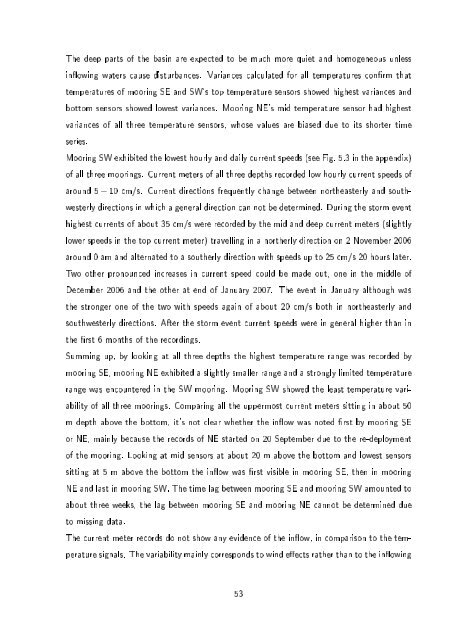Baltic Sea
Baltic Sea
Baltic Sea
Create successful ePaper yourself
Turn your PDF publications into a flip-book with our unique Google optimized e-Paper software.
The deep parts of the basin are expected to be much more quiet and homogeneous unless<br />
inowing waters cause disturbances. Variances calculated for all temperatures conrm that<br />
temperatures of mooring SE and SW's top temperature sensors showed highest variances and<br />
bottom sensors showed lowest variances. Mooring NE's mid temperature sensor had highest<br />
variances of all three temperature sensors, whose values are biased due to its shorter time<br />
series.<br />
Mooring SW exhibited the lowest hourly and daily current speeds (see Fig. 5.3 in the appendix)<br />
of all three moorings. Current meters of all three depths recorded low hourly current speeds of<br />
around 5 − 10 cm/s. Current directions frequently change between northeasterly and southwesterly<br />
directions in which a general direction can not be determined. During the storm event<br />
highest currents of about 35 cm/s were recorded by the mid and deep current meters (slightly<br />
lower speeds in the top current meter) travelling in a northerly direction on 2 November 2006<br />
around 0 am and alternated to a southerly direction with speeds up to 25 cm/s 20 hours later.<br />
Two other pronounced increases in current speed could be made out, one in the middle of<br />
December 2006 and the other at end of January 2007. The event in January although was<br />
the stronger one of the two with speeds again of about 20 cm/s both in northeasterly and<br />
southwesterly directions. After the storm event current speeds were in general higher than in<br />
the rst 6 months of the recordings.<br />
Summing up, by looking at all three depths the highest temperature range was recorded by<br />
mooring SE, mooring NE exhibited a slightly smaller range and a strongly limited temperature<br />
range was encountered in the SW mooring. Mooring SW showed the least temperature variability<br />
of all three moorings. Comparing all the uppermost current meters sitting in about 50<br />
m depth above the bottom, it's not clear whether the inow was noted rst by mooring SE<br />
or NE, mainly because the records of NE started on 20 September due to the re-deployment<br />
of the mooring. Looking at mid sensors at about 20 m above the bottom and lowest sensors<br />
sitting at 5 m above the bottom the inow was rst visible in mooring SE, then in mooring<br />
NE and last in mooring SW. The time lag between mooring SE and mooring SW amounted to<br />
about three weeks, the lag between mooring SE and mooring NE cannot be determined due<br />
to missing data.<br />
The current meter records do not show any evidence of the inow, in comparison to the temperature<br />
signals. The variability mainly corresponds to wind eects rather than to the inowing<br />
53



